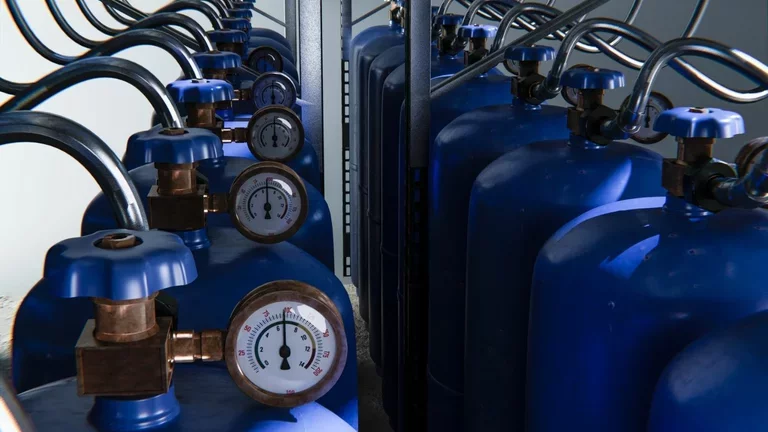Industrial Argon: The Ideal Gas for Advanced Industrial Applications

Industrial argon has become a crucial resource for a range of industries due to its unique properties, making it indispensable in applications that require a stable and non-reactive environment. As an inert gas, industrial argon provides a safe, controlled atmosphere that protects materials and enhances process efficiency. Available in both gaseous and liquid argon forms, this gas plays a vital role in areas such as welding, electronics manufacturing, and scientific research.
Key Applications of Industrial Argon
Industrial argon is valued for its non-reactive characteristics, making it ideal for shielding and inerting applications. Below are some of the most common uses of industrial argon across different industries:
1. Welding and Metal Fabrication
In the metalworking industry, industrial argon serves as a shielding gas in welding processes, such as MIG and TIG welding. By isolating the welding area from surrounding air, liquid argon helps prevent oxidation, which can weaken the weld and lead to defects. This process is essential for metals that are highly reactive with oxygen, like aluminum and stainless steel, ensuring a smooth, clean, and durable weld.
2. Electronics Manufacturing
The electronics industry relies on industrial argon for its high purity and inert qualities. In the production of semiconductors and other sensitive components, liquid argon is often used to maintain an atmosphere free from impurities. This reduces the risk of contamination, enabling the creation of precise electronic parts and circuits, which are crucial in producing reliable electronic devices.
3. Scientific Research and Laboratories
Industrial argon is frequently used in scientific applications, particularly in laboratories that require controlled environments for analytical procedures. Liquid argon is used in spectroscopy, chromatography, and even cryogenics due to its cooling capabilities. Its cryogenic form allows researchers to reach ultra-low temperatures, essential for experiments in physics, chemistry, and biology that require temperature control.
Benefits of Liquid Argon in Industry
Liquid argon is the preferred form for industries that need a continuous supply of argon gas. As a cryogenic liquid, it is stored in specialized liquid argon tanks that maintain it at low temperatures. This storage method offers several benefits:
- Consistent Supply: Large quantities of liquid argon supply can be stored, providing a steady supply for high-demand applications.
- Efficient Storage: Liquid argon tanks allow industries to store and transport argon safely and cost-effectively.
- High Purity: Because liquid argon is cryogenically processed, it achieves high levels of purity, making it suitable for sensitive applications like electronics manufacturing and laboratory research.
Using Liquid Argon Tanks for Storage and Transportation
Proper storage and handling of liquid argon are essential for maintaining safety and maximizing efficiency. Liquid argon tanks are specifically designed to keep the gas in its cryogenic state until it is needed. These tanks are insulated to maintain low temperatures and reduce the risk of leakage, ensuring the integrity of the liquid argon during transportation or storage.
When selecting liquid argon tanks, it’s important to consider the capacity and specific needs of the application. High-volume users in metal fabrication and large research institutions benefit from larger tanks, which provide a reliable, on-demand supply. Smaller operations may find more compact tanks beneficial, allowing them to meet their argon requirements without excess waste.
Advantages of Industrial Argon in High-Tech Applications
In today’s rapidly evolving technological landscape, industrial argon has found applications in high-tech fields such as 3D printing and laser cutting. These technologies demand precise and stable environments, and liquid argon is often utilized to ensure process reliability and product quality. The gas’s ability to prevent oxidation and contamination supports advancements in these innovative fields, making it an essential part of modern manufacturing.
Industrial argon also plays a role in emerging sectors, including renewable energy. In fuel cell production and solar panel manufacturing, argon gas is used to maintain purity in production environments, contributing to the efficiency and lifespan of renewable energy technologies.
Future of Industrial Argon Applications
The future of industrial argon looks promising as industries continue to innovate and explore new applications. With the growth of automated manufacturing, the demand for high-purity gases like argon is expected to rise, especially in sectors requiring precise atmospheric control. Additionally, as sustainability becomes a greater focus, liquid argon storage and efficient usage practices are likely to advance, reducing waste and supporting environmental goals.
In summary, industrial argon remains a vital resource across a range of fields, from traditional manufacturing to cutting-edge research. Its versatility, safety, and non-reactive nature, as outlined in argon safety data sheets, ensure it will continue to be a valuable gas for industries worldwide. These safety data sheets provide essential handling and storage guidelines, helping industries improve product quality, enhance safety, and drive innovation across numerous sectors.